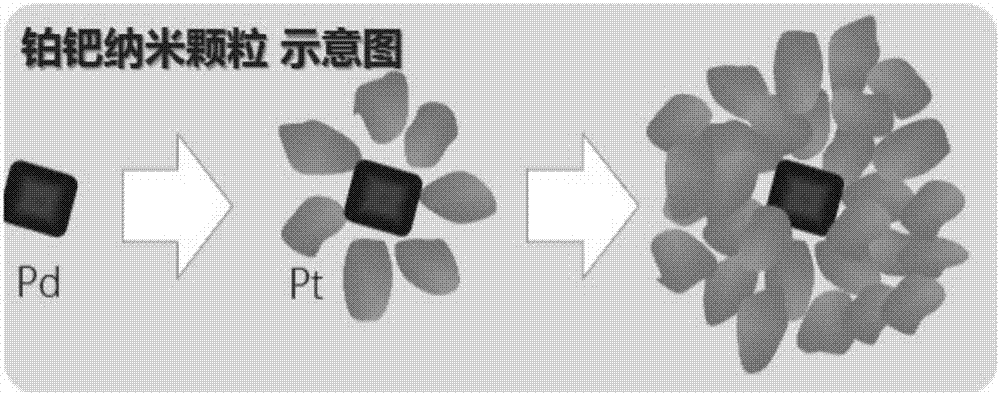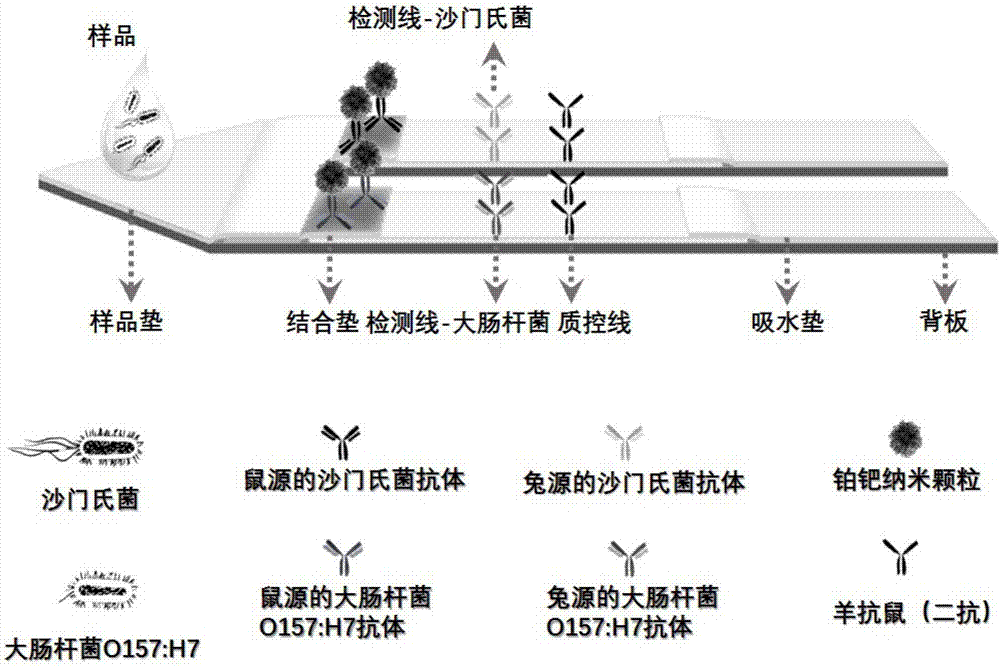Escherichia coli O157:H7 and salmonella typhimurium co-testing paper, preparation method and application thereof
A technology of O157 and Escherichia coli, which is applied in the direction of measuring devices, instruments, scientific instruments, etc., can solve the problems of poor sensitivity and difficult to overcome cross-reaction, and achieve the effect of strong sensitivity, improved specificity and good specificity
- Summary
- Abstract
- Description
- Claims
- Application Information
AI Technical Summary
Problems solved by technology
Method used
Image
Examples
Embodiment 1
[0050] Example 1 Preparation and assembly of Escherichia coli O157:H7 and Salmonella typhimurium co-detection test paper
[0051] 1. Preparation of platinum palladium nanoparticles
[0052] Glassware required for the preparation must be kept in freshly prepared aqua regia (HNO 3 :HCl=3:1) after soaking for 30 minutes, rinse with a large amount of double distilled water and dry in an oven for later use.
[0053] First, configure 20mM potassium tetrachloroplatinate solution (K 2 Ptcl 4 ), 20mM sodium tetrachloropalladate solution (Na 2 Pdcl 4 ), 6M hydrochloric acid solution and 100mM ascorbic acid solution. Then, 20 mg of F127 was weighed and dissolved in 1.8 mL of potassium tetrachloroplatinate solution (20 mM), then 0.2 mL of sodium tetrachloropalladate solution (20 mM) was added, and F127 was completely dissolved by ultrasonication for 5 min. Continue to add 44 μL of Hcl (6M) and 2 mL of ascorbic acid solution (100 mM), and sonicate for 4 hours. After centrifuging at ...
experiment example 3
[0068] Experimental example 3 utilizes the test paper prepared in embodiment 1 to carry out the detection of actual samples
[0069] In order to further verify the applicability of the sensor, a spike recovery experiment was carried out. Add 10 to 2.5mL milk and ice cream respectively 4 、10 5 CFU mL -1 coli O157:H7 and Salmonella typhimurium, mix for 1 min. Then, the sensor technology was used to quantitatively detect and analyze Escherichia coli O157:H7 and Salmonella typhimurium. The results showed (Table 1) that the recovery rate was between 91.44% and 109.56%, which proved that the sensor could be used for on-site detection.
[0070] Table 1 Recovery rate of Salmonella in artificially contaminated milk and ice cream
[0071]
PUM
| Property | Measurement | Unit |
|---|---|---|
| concentration | aaaaa | aaaaa |
| length | aaaaa | aaaaa |
| length | aaaaa | aaaaa |
Abstract
Description
Claims
Application Information
 Login to View More
Login to View More - R&D
- Intellectual Property
- Life Sciences
- Materials
- Tech Scout
- Unparalleled Data Quality
- Higher Quality Content
- 60% Fewer Hallucinations
Browse by: Latest US Patents, China's latest patents, Technical Efficacy Thesaurus, Application Domain, Technology Topic, Popular Technical Reports.
© 2025 PatSnap. All rights reserved.Legal|Privacy policy|Modern Slavery Act Transparency Statement|Sitemap|About US| Contact US: help@patsnap.com



